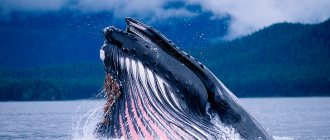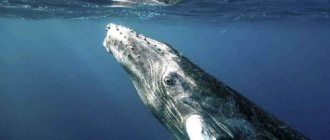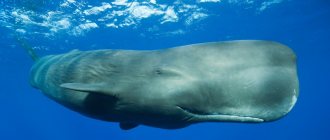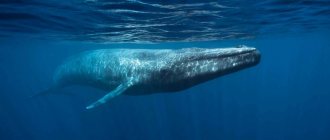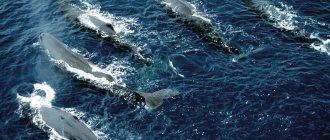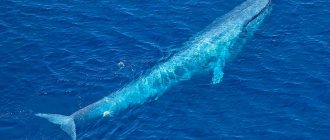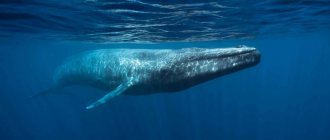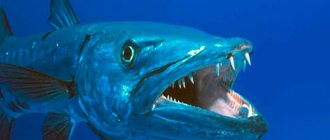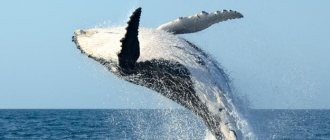Name
The first step is to answer the question that worries many. And it sounds like this: “Is a whale a fish or a mammal?” The second of the proposed options is correct.
The whale is a large marine mammal that is not related to porpoises or dolphins. Although they are included in the order Cetacea (cetaceans). In general, the situation with names is very interesting. Pilot whales and killer whales, for example, are considered whales. Although, in accordance with the strict official classification, they are dolphins, which few people know.
And it is better to trust a strict classification, since in the old days leviathans - sea multi-headed monsters that could devour the planet - were called whales. In a word, the name has an interesting story.
How does it reproduce
To reproduce, these mammals prefer to go to warm waters. Even the inhabitants of colder regions move to warmer conditions, this happens in winter.
The gestation period in mammals lasts from 9 to 16 months, the exact time depends on the species. Most often, only one baby is born, and it is born tail first. The baby whale then floats to the surface and breathes air into its lungs for the first time. Quite quickly, the offspring acquires swimming skills, as well as life skills in a new environment. A newly born whale practically does not swim away from its mother since it is much easier for them to swim and defend themselves from all rivals of any size. The offspring are born quite large, and also have a formed body, allowing them to easily adapt to new living conditions. Cetaceans have this opportunity due to the absence of pelvic bones; because of this, the size of the baby whale is not limited in any way.
The cubs feed very often; about fifteen minutes pass between feeding periods. The feeding process is quite simple - thanks to the contraction of special muscles, the milk itself is injected into the baby whale’s mouth. Its quantity varies from 250 ml to 250 liters at a time, it all depends on the size of the baby.
Unlike cow's milk, whale milk is many times more nutritious, and in concentration it is more reminiscent of thick sour cream. Thanks to this, it does not blur in water. Cubs begin to eat on their own at least four months after birth; this period can last up to a year, depending on conditions. Sometimes a baby whale needs to feed on its own earlier because the mother is expecting another replenishment, and no one gives him the right to choose.
Thanks to a well-developed parental instinct, offspring are almost never left alone and do not find themselves in life-threatening situations. Even if the tide is low, the mother will wait for the tide to rescue her baby. Parents of all bravely rushed to save their children who fell into the hands of whalers, they never need to say “choose your life or the life of a child”, the answer to the question is known in advance.
This was successfully used by people who caught adult mammals in this way. Caught animals were used not only for fat, bones and meat. Beluga whales can be found quite often in a circus on the water or in a dolphinarium, so this breed is the most valuable for whalers. Most often, cubs are hunted, since it is easier to teach them a variety of tricks, and also not to worry about the flashes of cameras taking photos of the performance.
The mutual assistance of these animals is at its best. They treat both their offspring and the whales of their brothers with equal reverence. They are always ready to come to the rescue and save a wounded relative or try to do so. Weak individuals (due to injuries or illnesses) are helped by their healthy counterparts. They surround their comrade and lift him to the surface of the water.
Origin
Well, the question “Is a whale a fish or a mammal?” was answered above. Now we can talk about the types of these creatures.
To begin with, it is worth noting that all whales are descendants of land mammals. Moreover, those who belonged to the orders of artiodactyls! This is not fiction, but a scientifically proven fact that was established after molecular genetic examinations. There is even a monophyletic group (clade) that includes whales, hippopotamuses and all artiodactyls. All of them are cetacean-toed ungulates. According to research, whales and hippos descended from the same creature that lived on our planet about 54 million years ago.
What is whalebone used for?
The thing is that this is the name given to special plates in the digestive system of whales. Together they form a kind of giant sieve through which these industrious mammals filter billions of tons of seawater, collecting food for their huge bodies.
By the way, if in the crossword you see something like “what does a whale eat, 5 letters”, then you can safely write the word “krill”, since it is the word that denotes the totality of those organisms that provide food for this marine animal.
But not all of these mammals give their preference to some crustaceans! We are talking about sperm whales, whose food is sometimes so large that it poses a danger even to the predator itself...
Units
So, now – about the types of whales. Or rather, about suborders. The first species is baleen whales. They are the largest of modern mammals. Their physiological feature is a mustache with a filter-like structure.
The second species is toothed whales. Carnivorous, fast creatures. They are superior to toothless whales. Only the sperm whale can compare in size with them. And their feature, as you might have guessed, is the presence of teeth.
And the third species is ancient whales. Those that no longer exist. They belong to a paraphyletic group of animals from which modern species of whales later evolved.
Where do whales live?
The habitat of whales is the world's oceans. Mammals are scattered across all latitudes, but in cold weather most migrate to warm waters and live near the coast. These are herd animals that prefer to live in groups with several dozen or hundreds of individuals. Whales migrate depending on the season. In winter and during the birthing period, whales and their females swim to warm waters, and in summer they are in waters of temperate or high latitudes.
Anatomical features
Now it’s worth considering the description of the whale from a physiological point of view. This animal is a mammal, and it is warm-blooded. Accordingly, each whale breathes with the help of its lungs, and the females feed their calves with milk. And these creatures have hair, albeit reduced.
Because these mammals are exposed to the sun, their skin has protection from ultraviolet rays. True, it is expressed differently in each species. A blue whale, for example, can increase the content of special pigments in its skin that absorb radiation (in simple terms, it “tans”). The sperm whale protects itself from oxygen radicals by triggering a “stress response.” The fin whale practices both methods.
By the way, these creatures maintain their warm-bloodedness due to the presence of a thick fatty layer under the skin. It is this that protects the internal organs of marine animals from hypothermia.
Where does the blue whale live?
Photo: Great blue whale
Previously, it was possible to meet vomiters in various parts of the world, but then their total numbers decreased significantly, and their habitat became fragmented. There are several zones in which this animal can now be found most often.
In summer, this is a belt of Arctic and Antarctic water bodies. In winter they travel closer to the equator. But they don’t like too warm water, and they almost never swim to the equator itself, even during migrations. But dwarf vomits live in the warm waters of the Indian Ocean all year round - they do not swim to the cold seas at all.
The migratory routes of vomits are still not fully understood, and we can only note where their presence has been recorded. The winter migration itself remained unexplained for a long time, because the food supply in the Arctic and Antarctic seas remains the same in winter. The most common explanation today is that this is required for cubs whose fat layer is insufficient to remain in cold waters in winter.
The most numerous groups of vomits are in the Southern Hemisphere; in the Northern Hemisphere they are found much less frequently, but sometimes they swim to the shores of Portugal and Spain, they were even met off the Greek coast, although they usually do not swim into the Mediterranean Sea. They can rarely be found off the coast of Russia.
Whale populations are distinguished (also called herds) - they almost do not mix with representatives of other populations, even if their habitats overlap. In the northern seas, researchers identify 9 or 10 populations; there is no such data regarding the southern seas.
Oxygen absorption process
It is also interesting to talk about how whales breathe. These mammals can stay under water for a minimum of 2 minutes and a maximum of 40. However, there is a record holder, and it is the sperm whale, which is able to stay under water for 1.5 hours.
The external nostrils of these creatures are located at the top of the head. They have special valves that reflexively close the airways when the whale dives into the water. At the moment of surfacing, they open. It is important to know that the airway does not connect to the esophagus. So the whale absorbs air safely, without harm to itself. Even if there is water in his mouth. And by the way, speaking about how whales breathe, it is worth noting that they do it quickly. Speed is facilitated by shortened bronchi and trachea. By the way, their lungs are very powerful. In one breath, the whale renews its air by 90%. And humans are only 15%.
It is worth noting that at the moment of surfacing, a column of condensed steam emerges through the nostrils (also called the blowhole). The same fountain that is the calling card of whales. This occurs due to the fact that the whale exhales warm air, which comes into contact with the outside (cold) air. So the fountain is the result of temperature effects. The column of steam varies in height and shape among different whales. The most impressive are the “fountains” of large mammals. They come out of their blowhole with such enormous power that the process is accompanied by a loud trumpet sound. In good weather it can be heard from the shore.
Reproduction method
Adults form a monogamous pair, choosing one partner.
Sexual maturity in these animals occurs at approximately 4-5 years. Full sexual development occurs by age 15.
The mating season is extended, as males can mate throughout the year. Childbirth occurs during the warm period of the year. Migrating species go to warm waters to give birth to their offspring.
The fetus is gestated for about 15-18 months. Baby whales are born able to move independently. One cub is born. Very rarely - two.
For about a year and a half, the female feeds him underwater with her milk, like all mammals. Whale milk is dense and high in calories, making it insoluble in water. During the feeding period, the baby doubles in size, and then begins to feed independently.
Kitikha is a very caring mother and protects her baby. During this period, males are nearby and try to protect their family.
Food
It’s worth saying a few words about what whales eat. The diet of animals is varied. Toothed whales, for example, eat fish, cephalopods (squid, cuttlefish) and in some cases mammals.
Whiskered representatives feed on plankton. They absorb a huge volume of crustaceans, filtering it from the water or using their baleen. These animals can also eat small fish.
The most interesting thing is that in winter whales hardly eat. And for this reason, in the summer they continuously consume food. This approach helps them accumulate a thick layer of fat.
By the way, they need a lot of food. Large whales consume about three tons of food per day.
Animal or fish
Whales are mammals, not fish.
The main differences are as follows:
- fish are cold-blooded, and whales are warm-blooded animals;
- whales do not spawn, but give birth to their young, then feed them with milk;
- fish are constantly in the water and breathe with gills, while animals have lungs and rise to the surface to breathe.
Instead of pectoral fins, whales have flippers. The tail of a whale is located horizontally, unlike fish. It is also interesting that each whale’s tail is individual and unique, like a person’s fingerprints.
The tail has powerful muscles, which ensures the movement of the animal.
Under the skin of the animal there is a huge number of nerve endings, due to which it has a very high level of touch.
Whale skin is smooth, but some species have hairs on their faces.
pixabay.com
Bright representative
The blue whale deserves special attention. This is the largest animal that has ever existed on our planet. It reaches 33 meters in length and weighs about 150 tons.
By the way, the blue whale is a representative of the baleen suborder. Feeds on plankton. It has a well-developed filtering apparatus, due to which it filters the absorbed mass inside.
There are three subspecies of this animal. There is a dwarf, southern and northern whale. The last two live in cold circumpolar waters. The dwarf is found in tropical seas.
It is believed that blue whales live for about 110 years. In any case, that was the size of the oldest individual people had ever encountered.
Unfortunately, the blue whale is not a very common marine creature. In the 20th century, uncontrolled hunting began for these animals. By the middle of the last century, only 5 thousand individuals remained throughout the world. People did a terrible thing by exterminating them. Emergency security measures were taken. At the moment, the number of individuals has doubled, but blue whales are still at risk.
Varieties
There are a great variety of cetaceans, but some of them are especially interesting in the photo.
Blue
It is not only the largest among whales, but also the largest animal in the whole world. It can be up to 33 m long and weigh up to 150 tons. It has a gray color, covered with gray spots. This gives the impression of a marble surface. Lives in all oceans. They feed on plankton.
A blue whale's stomach can hold about a ton of food at once. Unlike other species, it is a solitary animal and does not gather in flocks. It has an excellent memory and can recognize its parents after a long period.
Yandex.Pictures
Humpback
It has a pronounced fin on its back, similar to a hump. The animal reaches 14-18 m in length. It can be of different colors, and has several leathery protrusions on the surface of the head.
Its habitat is widespread in all oceans, in sea water with the exception of the waters of Antarctica and the Arctic. The beast feeds on shellfish and fish.
Belukha
This is a representative of the toothed whales of the narwhal family. The beluga whale is not very large. Its weight reaches only 2 tons, and its length is 6 meters. Beluga whales have excellent hearing, acute perception of any sounds, and the ability to echolocation. In addition, these are social creatures - there are known cases in which these whales saved a person. They get along well in aquariums, over time they get used to people, and even become attached to workers.
Their diet is varied. Beluga whales eat cod, flounder, herring, clams, algae, shrimp, lamprey, rib jellyfish, pink salmon, gobies, blennies, crayfish and many other sea creatures that are suitable for food.
These creatures, like many others, also suffered due to human cruelty. Whalers easily drove them onto the shallows, and the belugas literally crashed. But at the moment this species is gradually restoring its numbers. Let's just hope people don't ruin anything.
There are dozens of other representatives of cetaceans, and all are special and interesting in their own way. And we hope that every species that we know of will survive. The marine world should not lose any of them, as each of them is a true wonder and natural treasure.
Types of whales
Whales are divided into two types: toothless, which have baleen, and toothed. In total, there are more than 80 species in the family, of which several main ones can be distinguished.
Humpback whale
Humpback whale
The species got its name because of the shape of its dorsal fin, which resembles a hump. The body of individuals is shortened, and there are growths on the head. The color of the whale varies from gray to dark green, the belly is mostly white. Lives in all oceans except Antarctica and the Arctic. It eats only fish as food.
Gray whale
The gray whale
is the only species that collects food from the ocean floor. Thanks to a growth on the belly, the mammal digs up the mud and eats the organisms in it. The main part of the diet consists of snails, mollusks, worms and crustaceans. Body color is dark brown or gray. Gray whales live in the Bering, Okhotsk and Chukchi seas.
bowhead whale
Greenland whale
The color of individuals is dark blue or gray, the belly is light.
The species lives exclusively in cold waters and feeds on plankton. It can eat up to 2 tons of food per day. Interesting fact : one of the individuals of this species lived 211 years in the natural environment. However, the average lifespan of bowhead whales is 40 years.
Fin whale
Fin whale
feeds mainly on crustaceans. The fin whale's head is painted in two colors: the lower part is white, the upper part is dark brown. One of the few species that live in Antarctica and the Arctic. But in winter they still swim to warmer waters.
Dwarf whale
Dwarf whale
Lives in the waters of New Zealand and Australia. The color of individuals varies from gray to black, and there may also be light spots on the body. It feeds mainly on plankton. While moving, it moves its head left and right, which is why it swims along a wave-like trajectory.
Toothed whales
Unlike baleen whales, which swallow prey in bulk, toothed whales grab their victims one by one. Sperm whales and bottlenose whales feed on cephalopods. Small toothed whales primarily eat fish. Killer whales hunt warm-blooded animals - penguins, seals, their flocks attack large whales and tear them apart. In English, the killer whale is called a killer whale, that is, a killer whale.
Killer whale - a thunderstorm of seals
Sperm whale prey
The most impressive representative of toothed whales is the sperm whale. A seasoned male reaches 20 meters in length and weighs 50 tons. The sperm whale's prey is a match for the hunter - giant squids of the genus Architeuthis, which live at depths below 500 m.
When diving in search of food, the sperm whale is able to hold its breath for up to an hour and a half. The maximum proven diving depth of this whale is 2 km. Sunlight does not penetrate such a thickness of water, so the sperm whale searches for prey using echolocation. The loud clicks it makes muffle the squids and disorient them in space. But even a stunned giant squid is a dangerous opponent, especially for females and young whales.
Sperm whale and giant squid. Diorama at the Natural History Museum, USA
Although fights between sperm whales and krakens take place far from human eyes, it is easy to guess that the whale almost always emerges victorious. Whole heaps of “beaks” (squid jaws) are found in the stomachs of sperm whales. The skin of an adult whale is dotted with circles - battle scars from the suckers of cephalopods.
Not finding squid nearby, the sperm whale hunts other bottom inhabitants. The whale scares away those who are hiding (octopuses, stingrays and others), plowing through the mud with its lower jaw, which can open at a right angle. Nature has provided the sperm whale with a cunning bait - the white skin around its mouth is populated with phosphorescent bacteria. Deep-sea creatures willingly swim to the light - and end up straight for the sperm whale's lunch.
Sperm whale vs cable
Sometimes echolocation fails the sperm whale - it mistakes an underwater communication cable for squid tentacles. The whale acts as usual: it grabs onto the “tentacle” and begins to quickly rotate around its axis, trying to unscrew it. The giant's fate is decided - entangled in the cable, he suffocates. In the late 1960s, 14 cases of sperm whale attacks on underwater communications were recorded. Apparently, the “mass attack” was caused by a lack of usual food.
